A look back at the University of Michigan Law Quad's first buildings
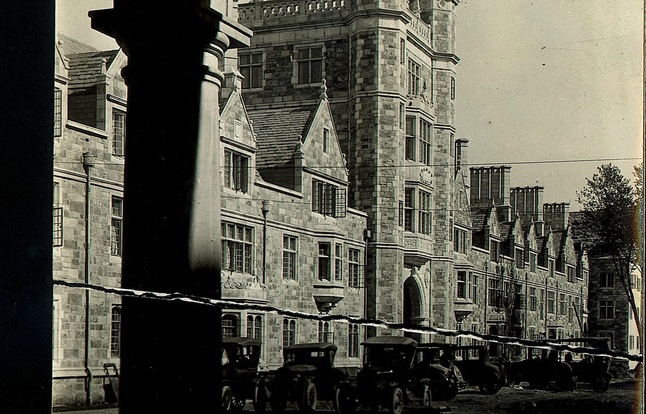
A photo of the Law Quad taken in the 1930s or 1940s.
Photo courtesy of U-M Bentley Historical Library
The University of Michigan Lawyers Club, a residence hall exclusively available to law students, recently received a $39 million renovation.
When residents arrive at the Law Quad they won't notice many remarkable changes to the 1920s-era Gothic-style building's exterior— crews didn't replace the building's windows or much of its stonework during the yearlong renovation.
Although the building's interior was completely gutted, U-M wanted to retain the historical and aesthetically stunning exterior of the Lawyers Club. The Lawyers Club and subsequent addition were the earliest buildings of the serene Law Quad— and their initial construction is chronicled in this edition of Michigan Memories.
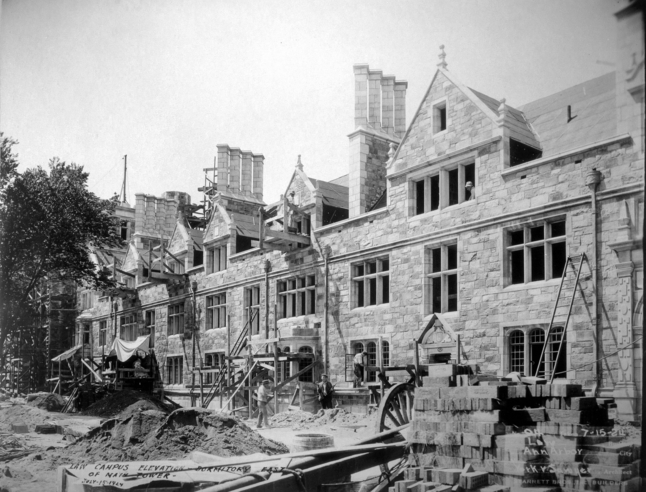
Photo courtesy of U-M Bentley Historical Library
Construction crews are pictured building the Lawyers Club in this 1920s image.
The original wings of the Lawyers Club, along State Street and South University Avenue, were built in 1924 and include a dining hall, a great lounge with high-vaulted ceilings and individual dorm rooms. The lounge still boasts a few pieces of original furniture, including a hutch, that adorned the Lawyers Club when it first opened nearly 90 years ago.
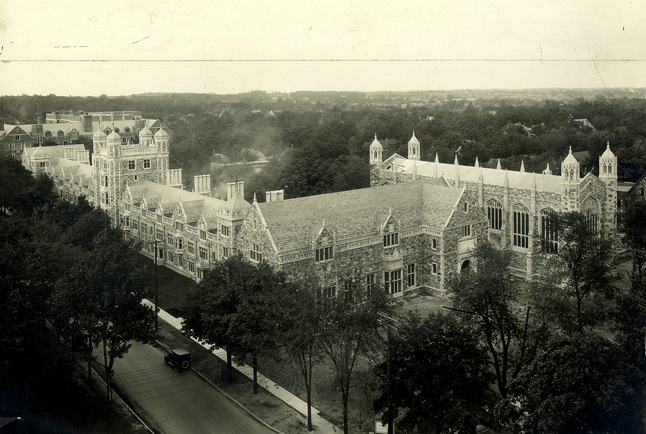
Photo courtesy of U-M Bentley Historical Library
The Lawyers Club, pictured here in 1928, was the first completed building on the Law Quad. It was followed by a dormitory addition in 1930, the Legal Research Building in 1931 and Hutchins Hall in 1933.
The Law Quad was modeled after English colleges like Oxford and Cambridge. Crews used granite and Indiana limestone in construction, according to U-M Bentley Historical Library archives.
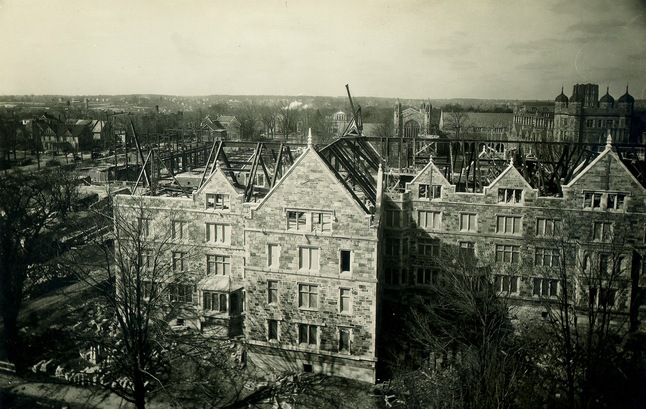
Photo courtesy of U-M Bentley Historical Library
An additional wing was competed in 1930 and named after John P. Cook, donor William Cook's father. The cost for much of the original law quad was funded by Cook, a U-M alum who practiced law in New York. The Cook wing is pictured above in 1930.
When the new wing opened, a U-M 1930 publication called Michigan Alumnus boasted that rooms in the addition had "running water, well chosen furnishings, and ample room for rest and study" and that "showers of the latest type are found in the bathrooms."
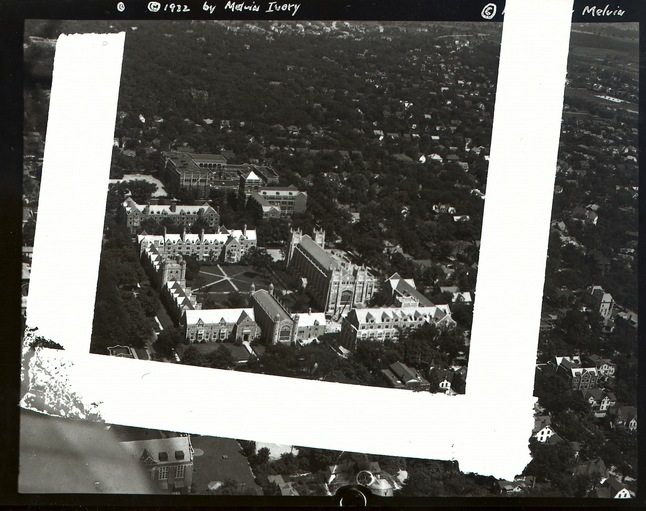
Photo courtesy of U-M Bentley Historical Library
The aerial was taken in 1932 and shows the Law Quad near completion. The Lawyers Club cost $2 million to build and the 4.3-million-square-foot John P. Cook addition cost about $550,800, according to Bentley records. After the most recent renovation, both wings accommodate 227 residents, about 30 fewer than before.
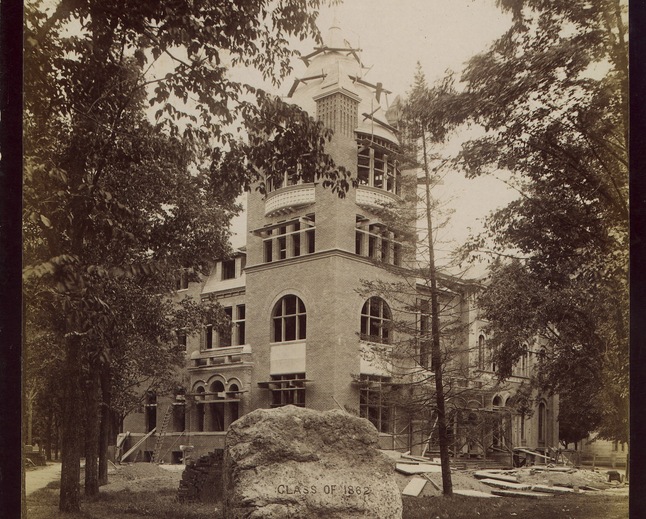
Photo courtesy of U-M Bentley Historical Library
The original law department building —where law studies were housed even before the Law School was considered its own college— is pictured above in 1893, 30 years after it was first built.
The building was located on the corner of State and North University and housed the law program for 60 years. The stone in the foreground of the image commemorates the class of 1862, according to Bentley records.
An 1898 addition altered the exterior, adding a south wing and removing the building's tower. Regents used to meet in the south wing. Law classes moved to Hutchins Hall when it was completed in the early 1930s. The original building, best known as Haven Hall, burned down in June 1950. The building originally cost $15,000 to build and underwent $95,000 in upgrades and expansions, according to records.
Kellie Woodhouse covers higher education for AnnArbor.com. Reach her at kelliewoodhouse@annarbor.com or 734-623-4602 and follow her on twitter.


Comments
Wystan Stevens
Sun, Sep 1, 2013 : 7:34 p.m.
Whoops! A couple of corrections to my post about the 1862 boulder: it was moved to campus in 1862, not 1860. It now rests in front of the former East Medical Building, which was renamed the C. C. Little Building, not the E. H. Kraus Building. (Dr. Little, a cancer researcher, was president of the U-M from 1925 to 1929.)
Wystan Stevens
Mon, Aug 26, 2013 : 7:15 p.m.
RE: The Class of 1862 memorial boulder. This boulder, a glacial erratic like the bigger one now at the corner of Hill and Washtenaw, was moved to campus on a stoneboat, drawn over winter ice, in 1860, by the Class of 1862, and placed, with great ceremony (and lots of noise) on the corner where it rested until the U-M Geology Department (which had coveted it for years) had it moved (c. 1969) next to their then-headquarters, in the courtyard south of the auditoriums, against the west wall of Angell Hall. Perhaps the motivation for this act of historical vandalism was fear that students and local hippies of that turbulent time would begin painting it with lewd pictures and/or obscene graffiti. Well, the Geology Department moved from that location several years ago, and ended up in the former East Medical Building -- now called the Edward H. Kraus Building. The stone-hearted scholars took the expropriated boulder with them, and placed it next to the East University Avenue entrance to their new digs. That part of East U is no longer open to traffic, but student pedestrians still pass the venerable pebble every day, as they scurry from dorm rooms to classes.
The Picker
Thu, Aug 29, 2013 : 3:55 a.m.
Not only the answer, but a good yarn as well ! Sometimes the commenters are the best sources for local information. Enjoy but verify !!!!!!!!!!
Kellie Woodhouse
Mon, Aug 26, 2013 : 7:25 p.m.
Wow, that is fascinating! Where did you get that information?
justcurious
Mon, Aug 26, 2013 : 4:05 p.m.
This building is the most beautiful building in Ann Arbor hands down. I don't even think the U has enough money to duplicate something like it today let alone find the craftsmen to do it. The addition is a poor site in comparison.
justcurious
Mon, Aug 26, 2013 : 4:06 p.m.
Ooops - sight, not site.
nicedoggy
Mon, Aug 26, 2013 : 11:58 a.m.
Thank you for the great story and photos.
The Picker
Mon, Aug 26, 2013 : 11:46 a.m.
Kellie, What ever became of the Rock commemorating the class of 1862 ?
The Picker
Thu, Aug 29, 2013 : 3:49 a.m.
I'm sure it hasn't gone far, considering you need a backhoe to move it. laying around in some Courtyard/ Diagonal/ Arboretum/ University dust bin ! Maybe we should try Property Disposition !!!
Kellie Woodhouse
Mon, Aug 26, 2013 : 3:48 p.m.
If you're really interested, it seems Bentley mint have a book that MIGHT have some information. http://mirlyn.lib.umich.edu/Record/003165280
Kellie Woodhouse
Mon, Aug 26, 2013 : 2:42 p.m.
I tried looking it up a few ways in Bentley, but couldn't find anything. Anyone know?
Tom Joad
Sun, Aug 25, 2013 : 9:50 p.m.
Attending law school is rapidly becoming a province of the elite. The proliferation of law schools in the USA has led to a glut of lawyers. But the most significant development that will render most jobs in the legal profession superfluous is the rapid development of sophisticated algorithmic programs that do the grunt work of most lawyers: Legal research. Many lower tier law schools, like Cooley, are doing their students a huge disservice in promoting a legal profession that can't possibly hire all their graduates. These graduates are then shacked with over $100,000 in debt to service. One would be well advised to read the book Automate This: How Algorithms Came to Rule by Christopher Steiner before deciding on a career in law. The AAPL has a copy for your perusal. Top, elite schools like Michigan will continue to lead the legal profession, but the profession is slated to be radically changed by algorithmic law programming.
Wystan Stevens
Sun, Aug 25, 2013 : 8:42 p.m.
Kellie, your first photo appears to be from the 1920s, not the thirties, and certainly not the forties. Those are all 1920s boxy cars, and the building appears to have construction materials still strewn around. The last photo shows the SECOND version of the original Law Building -- under construction in 1893. It lasted only five years. Critics absolutely hated that ugly, useless tower, and it got yanked down during a reappraisal of the campus' bad Victoriana, in 1898. My dad, a Professor of English, once had an office in Haven Hall, but luckily got moved out before the fire. Incidentally, the fire was the work of an arsonist, who struck on D-Day: June 6, 1950. After the wreckage got cleared away, nothing ever again was built where the old Law Building had stood.
Gene Alloway
Thu, Sep 5, 2013 : 9:18 p.m.
Too bad about the tower - I actually like it :).
justcurious
Mon, Aug 26, 2013 : 4:04 p.m.
Thanks for chiming in Wystan. I thought the same thing about the first photo...If it had been taken in the 40's then all of the law students had jalopies. (sp?)
Wystan Stevens
Sun, Aug 25, 2013 : 8:23 p.m.
While the Lawyers' Club dining hall is indeed a scaled-down version of the King's College Chapel, at Cambridge, the tower entrance to the Quadrangle (on South University Avenue) was taken from the original at Cardinal Wolsey's Hampton Court Palace. Other parts of the the Law Quad were inspired by the architecture of the Inns of Court, in London. It's also conceivable that fragments of Oxford buildings may have reappeared here.
Eduard Copely
Sun, Aug 25, 2013 : 12:55 p.m.
A little known fact (evidently) is that the freshly renovated Law Quad is a scaled down version of Kings College University, Cambridge, England and definitely not Oxford, which is a far older and different architectural style.
Linda Peck
Sun, Aug 25, 2013 : 12:35 p.m.
Very nice pictures and article.
David
Sun, Aug 25, 2013 : 11:12 a.m.
For more reading consider: Giving It All Away: The Story of William W. Cook and His Michigan Law Quadrangle Paperback by Margaret A. Leary
David
Sun, Aug 25, 2013 : 7:36 p.m.
...or the hardcover...(paste error) ;o)